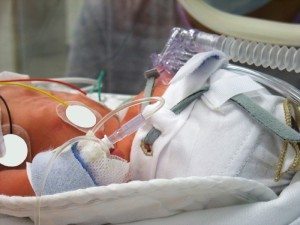Hypoxic Ischemic Encephalopathy / HIE and Cerebral Palsy (CP)
An established connection: HIE and cerebral palsy
There are many causes of cerebral palsy. Causes include birth asphyxia (hypoxic ischemic encephalopathy, HIE, neonatal encephalopathy, or NE), genetic problems, birth trauma, blood clotting issues, undetected or untreated maternal infections, and fetal malformations. In recent years, the medical community — including The American College of Obstetrics and Gynecology — has downplayed birth asphyxia as a cause of CP. Instead, they promote the antepartum problems (problems that occur before labor) as the main causes of CP. Given the fact that birth asphyxia is usually preventable, the medical community’s position is really not that surprising. Throughout this blog post, our Michigan birth injury lawyers will discuss the relationship between hypoxic ischemic encephalopathy / HIE and cerebral palsy (CP).
One of the foremost experts on the topic of birth asphyxia/HIE and its role in the development of cerebral palsy is Joseph Volpe. In his highly recognized and authoritative textbook called “Neurology of the Newborn,” Volpe provides significant and solid medical reasoning as to why there is a link between birth asphyxia/HIE and cerebral palsy. Volpe concludes that: “Indeed, if one considers the six large-scale studies of term infants born in the last 3 decades, the data are remarkably consistent in showing that 17% to 24% of cases of cerebral palsy are related to intrapartum (during labor and delivery) asphyxia.”
The National Institutes of Health further supports the link between birth asphyxia and CP by classifying HIE/intrapartum asphyxia as one of the four types of brain damage that causes cerebral palsy. [The others include: abnormal development of the brain (cerebral dysgenesis), damage to the white matter of the brain (periventricular leukomalacia), intracranial hemorrhage (bleeding into the brain)].
What Is Birth Asphyxia/ Hypoxic Ischemic Encephalopathy?

An infant receives hypothermia treatment for hypoxic ischemic encephalopathy (HIE)
Sometimes the stress of labor and delivery causes a temporary interruption in blood flow or oxygen levels to the baby. This occurs fairly frequently during the labor and delivery process but will usually correct itself. However, if blood flow and/or oxygen is completely cut-off or is at decreased levels for a long period of time, then birth asphyxia or hypoxic ischemic encephalopathy can occur and cause significant brain damage and cerebral palsy.
Some specific labor and delivery emergencies that are most commonly the cause of birth asphyxia include:
- problems with the placenta or uterus (e.g. ruptured uterus; placenta previa where the placenta is attached to the uterine wall close to or covering the cervix; or placental abruption where a portion of the placental lining tears away from the uterus)
- umbilical cord injuries (e.g. the cord gets wrapped around the baby’s neck, precedes the fetus’ exit from the uterus, or becomes compressed)
- excessively frequent uterine contractions
- elevated fetal heart resting tone in between contractions
- delayed delivery of the baby
- trauma to the baby’s brain during delivery
How Do You Know If Your Baby Suffered Birth Asphyxia?
Detecting and Diagnosing HIE and Cerebral Palsy
At birth, brain imaging studies like CT scans, PET scans and MRIs, blood tests, electroencephalogram (EEG), ultrasounds and other medical studies help diagnose birth asphyxia and its underlying causes. Some symptoms that may be associated with birth asphyxia include:
- Abnormal umbilical artery blood sample
- Apgar score of 0-3 for longer than 5 minutes
- Seizures, coma, decreased muscle tone
- Multiple organ involvement (eg, problems with kidneys, lungs, liver, heart, etc.)
My Child’s Cerebral Palsy Was Caused by Hypoxic Ischemic Encephalopathy: What Now?
Birth asphyxia is preventable in most cases. If you suspect that your child’s cerebral palsy was due to birth asphyxia and medical professionals’ errors, you may be eligible for compensation. Contact our Michigan birth injury attorneys. Our firm specializes in birth injury cases in Detroit, Grand Rapids, Warren, Ann Arbor, and other Michigan cities. Call us today for a free consultation.
